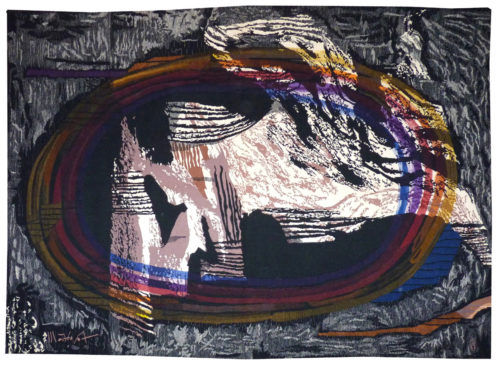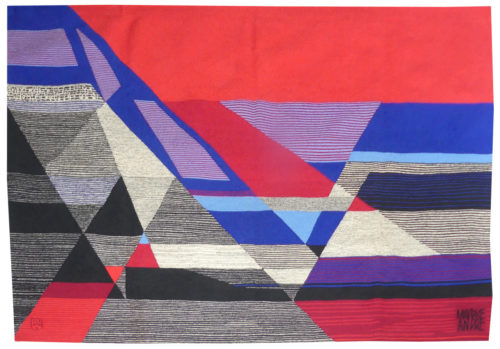-
Remous (swell)
Aubusson tapestry woven in the Tabard workshop. Circa 1960. Matégot, originally a decorator, then creator of artefacts and furniture (an activity he abandoned in 1959) met François Tabard in 1945 and gave him his first cartoons, first of all figurative then rapidly of abstract design in the 1950’s. He became a member of the A.P.C.T. (Association des Peintres Cartonniers de Tapisserie) in 1949, participated in many international exhibitions (Matégot, like Lurçat before him, was an untiring advocate of the art of tapestry) fulfilled numerous public commissions, sometimes of monumental proportions (“Rouen” 85m2 for the Préfecture of the Seine Maritime département, and also tapestries for Orly Airport, for the Maison de la Radio, for the IMF...) and designed no fewer than 629 cartoons up until the 1970’s. In 1990 the Matégot foundation for contemporary tapestry was inaugurated in Bethesda, U.S.A. Matégot is an artist, like Wogensky, Tourlière or Prassinos, who turns wool textiles resolutely towards the abstract: at first lyrical, geometric in the 70’s, exploiting various technical aspects of the loom : colour graduations, shading, irregularities... Remous can be seen as representative of Matégot’s production around 1960 : lyrical, playing with transparency, using all the technical expertise of the weavers (colour shading and grading…) Its evocative title is a reminder of the artist’s interest for aquatic subjects (cf “Régates”) treated in an abstract-metaphorical way. Bibliography : Exhibition Cat. Les tapisseries de Mathieu Matégot, galerie La Demeure, 1962 (ill.) Exhibition catalogue, Matégot, Angers, Musée Jean Lurçat et de la Tapisserie Contemporaine, 1990-1991 -
Maurice André settled in Aubusson for the duration of the second world war. A founding member of the group “Tapisserie de France” and a member of the A.P.C.T. (Association des Peintres-Cartonniers de Tapisserie), he developed a personal style, different from that of Lurçat, characterised by rigorous, cubist-influenced flat areas of colour, often using a limited palette ; he received large-scale public commissions for the Council of Europe in Strasbourg (“L’Europe unie dans le Travail et la Paix”) or for the French pavilion at the Brussels Exhibition in 1958 (“La Technique moderne au service de l’Homme”). Gradually (as with Wogensky and Prassinos,...) his style evolved towards more abstraction, firstly lyrical and then more and more geometric, in a way very similar to Matégot. Always geometric (going as far as pure abstraction in the 1970’s) Maurice André’s style is here limited to a cubic, kaleidoscopic vision : we can distinguish birds, roots, waves and perhaps a cage, …, all themes that can also be found in Lurçat’s work.Aubusson tapestry woven in the Picaud workshop. With signed label. 1974.




